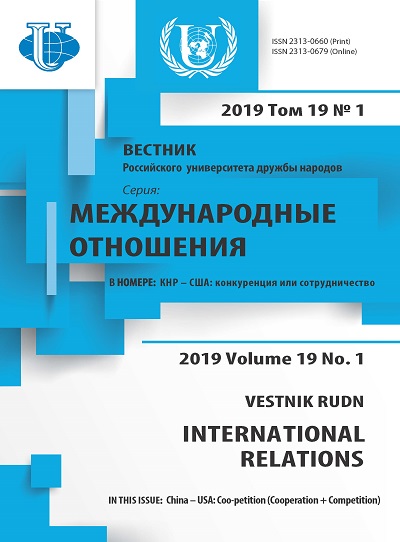США и КНР в Латинской Америке: контуры конкуренции
- Авторы: Яковлев П.П.1,2
-
Учреждения:
- Институт Латинской Америки РАН
- Российский экономический университет имени Г.В. Плеханова
- Выпуск: Том 19, № 1 (2019): КНР — США: конкуренция или сотрудничество
- Страницы: 47-58
- Раздел: ТЕМАТИЧЕСКОЕ ДОСЬЕ
- URL: https://journals.rudn.ru/international-relations/article/view/20851
- DOI: https://doi.org/10.22363/2313-0660-2019-19-1-47-58
Цитировать
Полный текст
Аннотация
Статья посвящена анализу сложной и противоречивой геополитической ситуации, складывающейся в Латинской Америке под влиянием глобальных процессов, одним из которых становится соперничество между Вашингтоном и Пекином за лидирующую роль на мировой арене. Автор показывает, что в последнее десятилетие в торгово-экономическом и финансовом отношении Латинская Америка оказывается все более «зажатой» между Соединенными Штатами и Китаем, на долю которых приходится свыше половины совокупного товарооборота латиноамериканских стран, а также решающая часть поступающих в регион инвестиционных и кредитных ресурсов. Данное обстоятельство оказывает сильнейшее воздействие на структуру и направленность внешнеэкономических связей и внешнеполитических контактов. В статье проводится идея, что в обозримой перспективе одна из сложностей внешней политики латиноамериканских стран будет заключаться в лавировании между США и КНР, которые втянулись в гибридную войну за доминирующие позиции в глобальной экономике и торговле. Особенно острый характер американо-китайские противоречия приобрели в Карибском бассейне, примером чему может служить венесуэльский кризис, который привлек широкое мировое внимание. Политика Вашингтона, направленная на свержение режима Н. Мадуро, способствовала расколу в рядах латиноамериканских стран и поставила под угрозу огромные экономические интересы Китая в Венесуэле. В этих условиях на первый план выдвигается задача поддержания безопасности в регионе, разрешения конфликтов мирным путем. Актуальное значение сохраняет диверсификация международных отношений латиноамериканских государств, расширение круга экономических и политических партнеров. Только таким путем можно ослабить гиперзависимость от Вашингтона и Пекина и нивелировать негативные эффекты силовых действий, протекционистской политики и торговых войн.
Ключевые слова
Об авторах
Петр Павлович Яковлев
Институт Латинской Америки РАН; Российский экономический университет имени Г.В. Плеханова
Автор, ответственный за переписку.
Email: petrp.yakovlev@yandex.ru
доктор экономических наук, руководитель Центра иберийских исследований Института Латинской Америки РАН, профессор кафедры международного бизнеса и таможенного дела Российского экономического университета имени Г.В. Плеханова
Список литературы
- Борзова А.Ю., Торкунова Ю.А., Агаев Ю.И. Китай - СЕЛАК: новые тенденции в экономическом сотрудничестве // Латинская Америка. 2018. № 7. С. 32-46. DOI: 10.31857/ S0044748X0000022-3.
- Лавут А.А. Новый этап развития китайско-латиноамериканских отношений // Латинская Америка. 2018. № 12. С. 59-73. doi: 10.31857/S0044748X0002316-6.
- Латинская Америка в современной мировой политике. М.: Наука, 2009.
- Яковлев П.П. Латинская Америка на мировой геополитической карте // Вестник Российского университета дружбы народов. Серия: Международные отношения. 2015a. Т. 15. № 4. С. 20-28.
- Яковлев П.П. Латинская Америка на переломе трендов (опыт осмысления новых явлений) // Латинская Америка. 2015b. № 7. C. 4-18.
- Яковлев П.П. «Эффект Трампа» или конец глобализации? М.: РУСАЙНС, 2017.
- Яковлев П.П. USMCA: перезагрузка зоны свободной торговли в Северной Америке // Латинская Америка. 2018. № 12. С. 6-21. doi: 10.31857/S0044748X0002312-2.
- Яковлева Н.М. Никарагуанский канал в светлое будущее // Латинская Америка. 2014. № 1. С. 34-47.
- Allison G. Destined for War: Can America and China Escape Thucydides’s Trap? New York: Houghton Mifflin Harcourt, 2017.
- CEPAL. Explorando nuevos espacios de cooperación entre América Latina y el Caribe y China. Santiago: Naciones Unidas, 2018.
- Chi-Kwan M. China and the World since 1945: An International History. London: Routledge, 2012.
- Fernandez J., Hogenboom B. Latin America facing China: South-South Relations beyond the Washington Consensus. New York: Berghahn Books, 2010.
- Hansen R. Relaciones económicas entre los Estados Unidos y América Latina: ¿bilaterales, regionales o globales? // Estudios internacionales. Santiago de Chile. 1975. Vol. 8. No 31. P. 59-99. doi: 10.5354/0719-3769.2011.17328.
- Holden R., Zolov E. Latin America and the United States: A Documentary History. London: Oxford University Press, 2000.
- Gramer R., Johnson K. Tillerson Praises Monroe Doctrine, Warns Latin America of ‘Imperial’ Chinese Ambitions. 2018. URL: https://foreignpolicy.com/2018/02/02/ (accessed: 23.12.2018).
- Katz F. The Secret War in Mexico: Europe, the United States, and the Mexican Revolution. Chicago: University of Chicago Press, 1981.
- Latin America Confronts the United States: Asymmetry and Influence. Cambridge: Cambridge University Press, 2015.
- Mallo T., Sanahuja J.A. (coords.). Las relaciones de la Unión Europea con América Latina y el Caribe. Madrid: Fundación Carolina/Siglo XXI. 2011.
- Palomares L.G. Trump y una América Latina en transformación: de la política de muro a la estrategia de sustitución // Revista Tribuna Norteamericana. Alcalá de Henares. 2017. No 25. P. 22-29.
- Paz G., Roett R. China’s Expansion into the Western Hemisphere. Washington: Brookings Institution, 2008.
- US Policy Toward China: Recommendations for a New Administration. New York: Asia Society Center, 2017.
- Xu Yanran. China’s Strategic Partnerships in Latin America: Case Studies of China’s Oil Diplomacy in Argentina, Brazil, Mexico, and Venezuela, 1991-2015. Lexington: Lexington Books, 2016.











